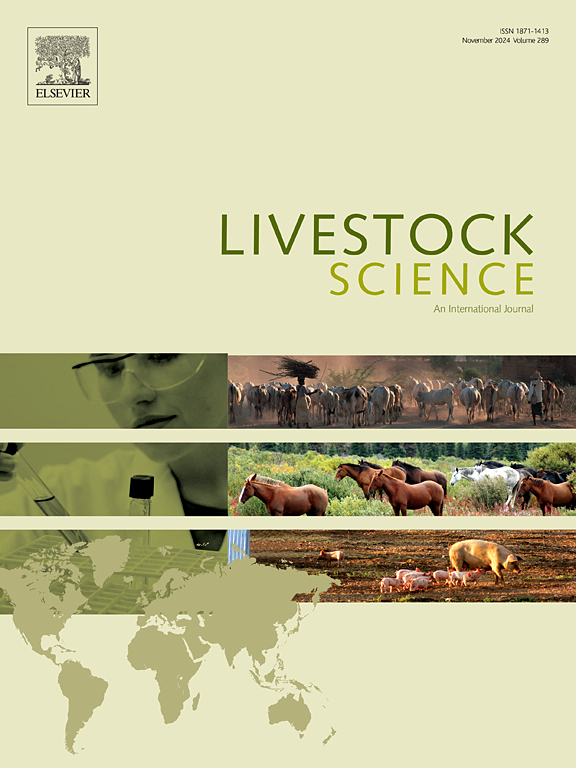Intake, feed efficiency, carcass traits, muscle colour and sensory characteristics of beef from steers offered grass silage and barley-based supplementary concentrates with increasing levels of dry corn gluten feed
IF 1.9
3区 农林科学
Q2 AGRICULTURE, DAIRY & ANIMAL SCIENCE
引用次数: 0
Abstract
Increasing awareness of feed-food competition means the inclusion of human-inedible by-product feed ingredients rather than cereals in concentrate feedstuffs for beef cattle is now preferred. The objective of the present experiment was to evaluate the complete replacement of soya bean meal and partial replacement of rolled barley with increasing levels of dry corn gluten feed (DCGF) in the concentrate supplement to grass silage on intake, growth, carcass traits and meat quality attributes of finishing beef cattle. The control concentrate (DCGF-0) was based on rolled barley (865 g/kg fresh weight) and soya bean meal (60 g/kg fresh weight). In three other concentrates, barley and all the soya bean meal was replaced with either 250 g/kg (DCGF-250), 500 g/kg (DCGF-500) or 750 g/kg (DCGF-750) fresh weight of DCGF. Forty-eight late-maturing breed suckler steers were individually offered Lolium perenne dominant grass silage ad libitum supplemented with 4.0 kg dry matter (DM) of the respective concentrates daily, for 124 days. Inclusion of DCGF in the concentrate had no effect on silage DM intake, daily live weight gain, feed conversion ratio, pre-slaughter weight, ultrasonic measures of body fat, carcass weight, estimated carcass gain, kill-out proportion, carcass conformation score, carcass fat score, carcass fat depth or on subcutaneous fat redness, yellowness and saturation. There was a linear increase (P < 0.01) in subcutaneous fat lightness and hue as DCGF inclusion level increased. Inclusion of DCGF in the concentrate had no effect on ultimate pH, temperature, drip loss, colour or meat sensory characteristics of the M. Longissimus dorsi muscle. Under the conditions of this experiment, DCGF had a feeding value comparable to that of rolled barley (+ soya bean meal) with little effect on meat quality, when included at up to 750 g/kg fresh weight in a concentrate supplement to grass silage. The overall implication of these findings is that the human-edible food-feed efficiency of beef production can be enhanced further by the use of DCGF.
采食量、饲料效率、胴体性状、肌肉颜色和感官特性随干玉米面筋饲料水平的增加而增加
对饲料与食品竞争的意识日益增强,这意味着在肉牛的浓缩饲料中加入人类不可食用的副产品饲料成分,而不是谷物,现在是首选。本试验旨在评价在草青贮精料中添加高水平干玉米蛋白饲料(DCGF)完全替代豆粕和部分替代大麦对育肥牛采食量、生长、胴体性状和肉质性状的影响。对照浓缩物(DCGF-0)以大麦(865 g/kg鲜重)和豆粕(60 g/kg鲜重)为基础。在其他三种浓缩物中,大麦和所有豆粕都被250克/公斤(DCGF-250)、500克/公斤(DCGF-500)或750克/公斤(DCGF-750)新鲜重量的DCGF取代。试验选用48头晚熟种哺乳阉牛,分别饲喂多年生黑麦草优势草青贮,每天添加4.0 kg干物质(DM),连续饲喂124 d。精料中添加DCGF对青贮DM采食量、日活增重、饲料系数、宰前重、体脂超声测量、胴体重、胴体增重、估计胴体增重、屠宰比例、胴体形态评分、胴体脂肪评分、胴体脂肪深度及皮下脂肪红度、黄度和饱和度均无影响。呈线性增长(P <;随着DCGF包埋水平的升高,皮下脂肪亮度和色相的变化均为0.01)。浓缩物中加入DCGF对背最长肌的最终pH值、温度、滴水损失、颜色和肉感特征没有影响。在本试验条件下,在草青贮精料中添加高达750 g/kg鲜重的DCGF,其饲用价值与大麦(+豆粕)相当,对肉品质影响不大。这些发现的总体含义是,使用DCGF可以进一步提高牛肉生产的人类可食用食品饲料效率。
本文章由计算机程序翻译,如有差异,请以英文原文为准。
求助全文
约1分钟内获得全文
求助全文
来源期刊

Livestock Science
农林科学-奶制品与动物科学
CiteScore
4.30
自引率
5.60%
发文量
237
审稿时长
3 months
期刊介绍:
Livestock Science promotes the sound development of the livestock sector by publishing original, peer-reviewed research and review articles covering all aspects of this broad field. The journal welcomes submissions on the avant-garde areas of animal genetics, breeding, growth, reproduction, nutrition, physiology, and behaviour in addition to genetic resources, welfare, ethics, health, management and production systems. The high-quality content of this journal reflects the truly international nature of this broad area of research.
 求助内容:
求助内容: 应助结果提醒方式:
应助结果提醒方式:


